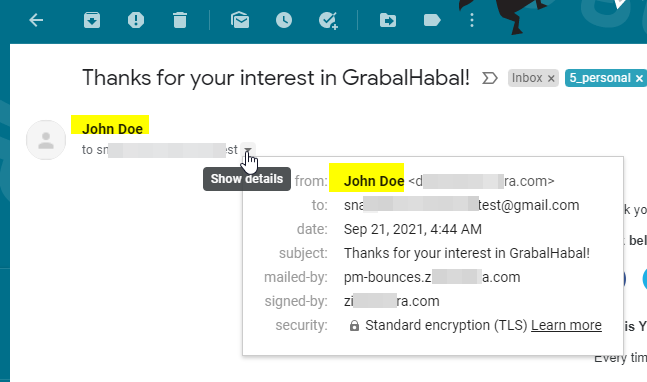Why Inaccurate “From” Information Sends Emails to Spam
Inaccurate “From” info in emails is one of the major spam triggers.
Even if your email content seem perfect, spam filters rely heavily on the sender field to determine the legitimacy and deliverability of the emails.
In this article, we’ll find out why emails with wrong sender information are punished and how you can avoid it.
What does the “From” field in an email actually mean?
The “From” field in an email shows who the message is from. It includes a display name and an email address, like John from CoffeeCo [email protected]

*example of a “from” information in email (credit)
This information helps the recipient and their email service decide if the message is safe and trustworthy.
Sometimes, senders use names or email addresses that look suspicious, such as:
Customer Service [email protected]
Or worse:
Amazon Billing [email protected]
These names and addresses don’t clearly identify the sender or match the brand. That’s a problem.
The built-in email spam filters inside the email services(Gmail, Yahoo, Outlook etc.) check this field to detect signs of spam, scams, or phishing.
Why inaccurate ‘From’ information sends emails to SPAM
Below are some practical reasons why this happens –
1) Using misleading names
Spam filters are built to spot fraud.
When your sender name sounds like you’re pretending to be a well-known brand like “Amazon Support” or “Netflix Billing”, filters assume it’s a phishing attempt.

*example of a suspicious email with wrong sender email address
Even generic terms like “Customer Support” or “Important Update” without clear branding make your email look shady.
Small inconsistencies like using a friendly name that doesn’t match your domain can be enough to send your email to the Promotions tab or spam folder.
Unclear or overly generic names lower trust, causing even legitimate emails to be flagged as spam.
Always use a real name and a brand indicator .
“Sam at HomeBrew Tools” is much more trustworthy sender than “Admin Department.”
This video describes this incident in details:
2) Sending from free or mismatched email domains
Email services match the domain in your “From” address with your website and other authentication records.
If you use a free Gmail or Yahoo address for business purposes, your email instantly looks unauthenticated.

*example of a fake email with mismatched domain and user name (credit)
And if your links go to one domain but your email address belongs to another, filters see it as suspicious.
Spam filter algorithms treat these mismatches as signs of spoofing or fraud.
Most email users report switching from a free Gmail address to a domain-based address (e.g., [email protected]) instantly improves inbox rate.
3) Changing senders too often
Consistency builds trust.
Spam filters track your sender address history and recipient behavior.
When you change your From name or address often, it resets this trust history.
If you send a newsletter from “info@” one week and “marketing@” the next, filters treat each one as a new sender.
It is always recommended to warm up new sender email addresses gradually and avoid sudden tone or identity shifts in your From name.
Frequent changes make you look like a spammer trying to avoid detection.
4) Contact forms that use visitor emails in the from field
Some websites automatically set the visitor’s email as the “From” address when relaying form submissions.
While this seems helpful, it breaks the rules of email authentication.
Your server isn’t authorized to send on behalf of the visitor’s domain, and that mismatch triggers spam flags.
Instead, use your domain email as the “From” address (like [email protected]) and place the visitor’s email in the “Reply-To” field.
Stack Overflow users confirm this is one of the most overlooked causes of form-related spam issues.
5) Using all Caps, emojis, or spammy words in sender names
Spam filters also analyze the sender name formatting.
Names like “🔥FREE OFFER🔥” or “ACT NOW – WIN BIG!” are linked to scam campaigns.
Emojis, excessive punctuation, and buzzwords in the From name can trigger blocks, especially on Gmail and Outlook.
At times, even when the body of the email body is clean, the sender name alone can land your email in spam.
Use plain, clear names that reflect your actual identity.
As noted by Chad S. White, Head of Research at Oracle Digital Experience:
“The ‘From’ field is your email’s first impression. Get it wrong, and even the most engaging content won’t save your campaign from the spam folder.”
6) Inaccurate from info hurts email sender reputation
Email providers assign a reputation score to your domain and IP (called “sender reputation”). It’s like a credit score for your email trustworthiness.
If you keep sending mismatched or confusing “From” addresses, recipients may report your emails as spam, which worsens your reputation as a sender.
Once your domain/IP gets a low score, even well-crafted emails will bypass the inbox.
Read more: What is Sender Reputation and Why Do My Cold Emails Go to Spam?
7) Inaccurate sender fails email authentication protocols
SPF tells email services which servers are allowed to send on behalf of your domain.
DKIM attaches a digital email signature that proves your email wasn’t altered in transit.
DMARC ties them together and tells mailbox providers what to do if an email fails both checks.
If your “From” address isn’t aligned with your SPF and DKIM setup, spam filters won’t just mistrust your message they will reject it outright.
This is especially very true for email services like Gmail and Outlook.
Read more: How to set up SPF, DKIM & DMARC to keep emails out of spam
How to fix and avoid these inaccurate email sender related issues
While we won’t go into detailed setup steps here, a few key things matter:
- Use your real secondary email domains and clear, recognizable email sender names.
- Avoid free email services for business communication.
- Stay consistent with your sender name and address.
- Make sure your domain is properly authenticated.
For a step-by-step guide on fixing these issues, check out this detailed guide on “The next article will be added here”
Frequently asked questions (F.A.Qs)
Q. Why does Gmail send my emails to spam even if I’m a real sender?
Because your “From” address might not match your domain or lacks authentication like SPF/DKIM.
Q. Can I use Gmail or Yahoo to send marketing emails?
Technically yes, but spam filters hate it. Always send from a domain you own.
Q. What is DMARC and how does it relate to the From field?
DMARC checks if your “From” email matches your domain and passes SPF or DKIM checks. If not, it can block your emails.
Q. Why is changing my “From” name often a bad idea?
Inconsistency confuses users and spam filters. It lowers trust and engagement.
Q. Do I need to show a person’s name or a company name?
Either is fine just make sure it’s accurate and recognizable.



